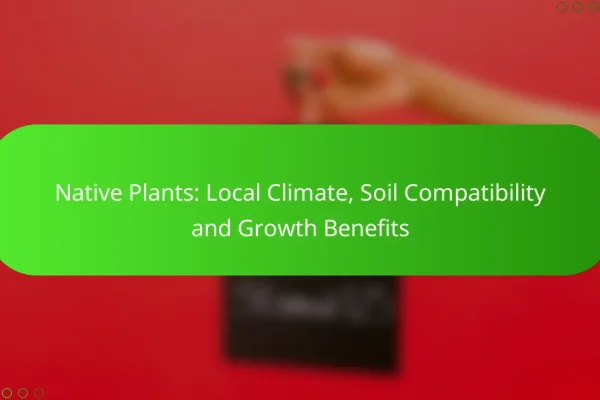What are the best plants for South African gardens?
The best plants for South African gardens are those that thrive in the local climate, which ranges from arid to temperate. Selecting a mix of indigenous species, drought-resistant plants, and vibrant flowering plants can create a sustainable and visually appealing garden.
Indigenous species
Indigenous plants are well-adapted to South Africa’s diverse climates and soils, making them a great choice for local gardens. Examples include the Protea, which is not only stunning but also attracts pollinators, and the Aloe, known for its resilience and low maintenance needs.
Using indigenous species helps preserve local biodiversity and can reduce water usage, as these plants are naturally suited to the environment. Consider incorporating a variety of these plants to create a dynamic and ecologically friendly garden.
Drought-resistant plants
Drought-resistant plants are essential for gardens in South Africa, especially in areas prone to water scarcity. Succulents like Echeveria and Sedum are excellent choices, as they store water in their leaves and require minimal irrigation.
When selecting drought-resistant plants, look for those with thick, waxy leaves or deep root systems, which help them survive dry conditions. Grouping these plants together can create a stunning xeriscape that conserves water while providing visual interest.
Flowering plants for year-round color
To ensure your garden has color throughout the year, choose a mix of flowering plants that bloom in different seasons. South African favorites include the Bougainvillea, which offers vibrant blooms in summer, and the Gazania, which can brighten up winter gardens.
Consider planting a variety of species that flower at different times to maintain continuous color. Regular deadheading and proper care will also encourage more blooms, enhancing the overall beauty of your garden.
How to choose plants for biodiversity?
Choosing plants for biodiversity involves selecting a variety of species that support different forms of wildlife and contribute to a balanced ecosystem. Focus on native plants, pollinator-friendly options, and companion planting strategies to enhance biodiversity in your garden or landscape.
Native plant selection
Native plants are those that naturally occur in a specific region and have adapted to the local climate and soil conditions. Selecting native species is crucial as they provide habitat and food for local wildlife, including birds, insects, and other organisms.
When choosing native plants, research your local flora to identify species that thrive in your area. Consider factors such as soil type, sunlight, and moisture levels. A diverse selection can include grasses, shrubs, and flowering plants that bloom at different times throughout the year.
Pollinator-friendly options
Pollinator-friendly plants are essential for supporting bees, butterflies, and other pollinators that play a vital role in plant reproduction. Choose flowers that are rich in nectar and pollen, and aim for a mix of colors and shapes to attract various pollinator species.
Examples of pollinator-friendly plants include coneflowers, milkweed, and lavender. Planting in clusters rather than single specimens can make it easier for pollinators to find and access food sources. Avoid using pesticides that can harm these beneficial insects.
Companion planting strategies
Companion planting involves growing different plants together to enhance growth, deter pests, and improve yields. Certain plant combinations can naturally repel harmful insects or attract beneficial ones, creating a healthier ecosystem.
For instance, planting marigolds alongside vegetables can deter nematodes and other pests. Similarly, pairing basil with tomatoes can enhance flavor and growth. Research compatible plants to maximize the benefits of companion planting in your garden.
What are the benefits of plant diversity?
Plant diversity offers numerous benefits, including enhanced ecosystem stability, improved aesthetics, and support for various wildlife species. By incorporating a wide range of plants, ecosystems become more resilient and visually appealing while providing essential habitats for animals.
Improved ecosystem resilience
Diverse plant communities contribute to ecosystem resilience by enhancing stability and reducing vulnerability to pests and diseases. When a variety of species coexist, they can better withstand environmental changes, such as droughts or floods, compared to monocultures.
To promote resilience, aim for a mix of native and non-invasive species that thrive in your local climate. Consider planting perennials alongside annuals to ensure year-round coverage and minimize soil erosion.
Enhanced aesthetic appeal
Plant diversity significantly enhances the aesthetic appeal of landscapes, creating visually interesting and dynamic environments. A mix of colors, textures, and heights can transform a space, making it more inviting and enjoyable.
Incorporate flowering plants, shrubs, and trees with varying foliage to create layers and depth. Seasonal changes in plant life can also provide ongoing visual interest throughout the year.
Support for wildlife
Plant diversity plays a crucial role in supporting wildlife by providing food and habitat for various species. Different plants attract a range of pollinators, birds, and beneficial insects, fostering a balanced ecosystem.
To attract wildlife, include a variety of flowering plants, fruit-bearing shrubs, and native grasses. This approach not only supports local fauna but also encourages natural pest control, reducing the need for chemical interventions.
How does climate affect plant selection in South Africa?
Climate plays a crucial role in plant selection in South Africa by determining which species can thrive in various regions. Factors such as temperature, rainfall, and seasonal variations influence the types of plants that can be successfully cultivated.
Understanding local climate zones
South Africa has diverse climate zones, including Mediterranean, semi-arid, and subtropical regions. Understanding these zones helps gardeners and farmers choose plants that are well-suited to their specific environment. For example, the Western Cape’s Mediterranean climate supports vines and olives, while the eastern regions favor tropical fruits.
To effectively select plants, consider the average temperature ranges and rainfall patterns in your area. This knowledge allows for better planning and increases the chances of successful growth.
Seasonal planting considerations
Seasonal variations significantly impact when to plant different species in South Africa. The growing season typically aligns with the summer months, but local conditions can vary widely. For instance, in the northern regions, planting can occur as early as September, while in cooler areas, it may be better to wait until October or November.
It’s essential to monitor local weather patterns and adjust planting schedules accordingly. Avoid planting during extreme heat or heavy rainfall, as these conditions can hinder seed germination and plant establishment. A good rule of thumb is to plant after the last frost date in your area to ensure optimal growth conditions.
What are the prerequisites for successful planting?
Successful planting requires understanding the specific needs of plants, including soil quality, water availability, and drainage. Addressing these factors ensures healthy growth and minimizes the risk of plant failure.
Soil testing and preparation
Soil testing is essential to determine pH levels, nutrient content, and soil type, which influence plant selection and growth. Conduct tests using kits available at garden centers or through local agricultural extensions to assess these factors.
Once testing is complete, prepare the soil by removing debris, tilling, and amending it with organic matter or fertilizers based on test results. Aim for a loamy texture, which balances drainage and nutrient retention, ideal for most plants.
Watering and drainage requirements
Understanding watering needs and drainage is crucial for plant health. Different plants have varying water requirements; some thrive in moist conditions while others prefer drier soil. Research the specific needs of your chosen plants to avoid overwatering or underwatering.
Ensure proper drainage by testing the soil’s ability to absorb water. If water pools, consider raised beds or amending the soil with sand or perlite to enhance drainage. A general rule is to aim for soil that remains moist but not soggy, allowing roots to breathe while accessing necessary moisture.
How to create a diverse garden layout?
To create a diverse garden layout, incorporate a variety of plants that differ in height, color, and texture. This not only enhances visual appeal but also supports local wildlife and promotes a healthier ecosystem.
Layering plants for visual interest
Layering plants involves arranging them in tiers based on their height and growth habits. Taller plants should be placed at the back or center, with medium and shorter plants in front, creating depth and dimension.
Consider using a mix of perennials and annuals to ensure continuous blooms throughout the seasons. For example, combine sunflowers and hollyhocks with lower-growing marigolds and petunias to create a vibrant display.
Creating microhabitats
Microhabitats are small, specialized environments that can support diverse plant and animal life. By incorporating elements like rock piles, water features, or native grasses, you can attract beneficial insects and birds.
For instance, a small pond can serve as a habitat for frogs and dragonflies, while a rock garden can provide shelter for lizards and insects. Aim to include a variety of textures and materials to enhance biodiversity in your garden.
What are the emerging trends in plant selection?
Emerging trends in plant selection focus on sustainability, biodiversity, and climate resilience. Growers are increasingly prioritizing native species, drought-resistant varieties, and plants that support local ecosystems.
Native Plant Selection
Native plant selection emphasizes using species that naturally occur in a specific region. These plants are often better adapted to local soil, climate, and wildlife, leading to lower maintenance and higher survival rates.
When selecting native plants, consider factors such as soil type, moisture levels, and sunlight exposure. For example, in the United States, plants like coneflowers and black-eyed Susans thrive in various conditions and attract pollinators.
Drought-Resistant Varieties
Drought-resistant varieties are becoming essential as climate change increases water scarcity. These plants require less irrigation and can survive prolonged dry periods, making them ideal for arid regions.
Examples include succulents and certain grasses that can withstand low water availability. When choosing drought-resistant plants, look for local varieties that have adapted to your specific climate conditions.
Supporting Biodiversity
Supporting biodiversity through plant selection involves choosing a variety of species that promote ecological balance. This approach helps sustain wildlife, improves soil health, and enhances resilience against pests and diseases.
Consider creating a diverse planting scheme that includes a mix of flowering plants, shrubs, and trees. This diversity not only provides habitats for various species but also creates a more visually appealing landscape.












